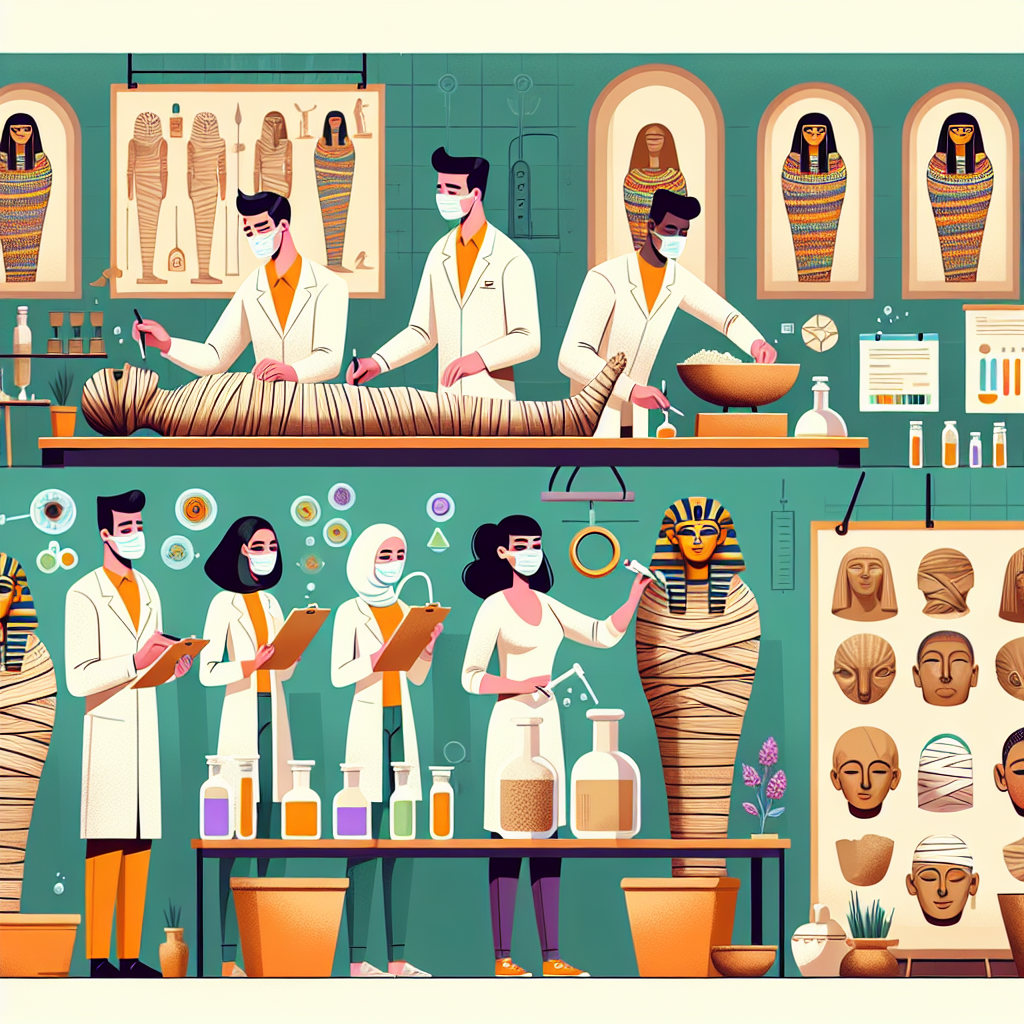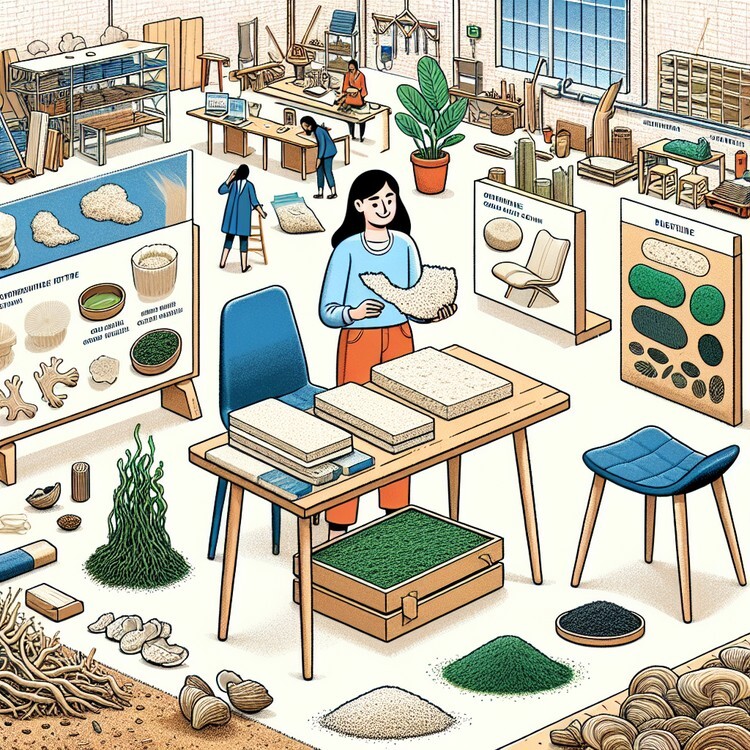Researchers have recently conducted an intriguing study on the scents emitted by nine mummified bodies, revealing that ancient Egyptian mummies possess aromas described as “woody,” “spicy,” and “sweet.” This unique investigation employed what the researchers referred to as “trained, human sniffers” alongside advanced equipment resembling an electronic nose. The study highlights the significance of smell in the mummification process, suggesting that the ancient Egyptians intentionally used various resins and oils, such as pine, cedar, and juniper, to create pleasant aromas that have endured for over 5,000 years.
The findings of this research, published in the Journal of the American Chemical Society, indicate that scent analysis can serve as a non-invasive method for examining preserved bodies. The researchers aim to recreate these ancient smells in museum settings, thereby enhancing the visitor experience and providing a more immersive understanding of mummified artifacts. This innovative approach not only sheds light on the mummification practices of ancient Egyptians but also emphasizes the role of olfactory experiences in cultural heritage.
The study was a collaborative effort involving teams from University College London (UCL) and the University of Ljubljana in Slovenia, along with conservators and curators from the Egyptian Museum in Cairo. Lead author Professor Matija Strlic noted that the fascination with the smell of mummified bodies has long captivated both experts and the public. However, this research marks the first comprehensive chemical and perceptual study of its kind, contributing valuable insights into the conservation of mummies and the materials used in ancient embalming.
Co-author Professor Ali Abdelhalim, who also serves as the director of the Egyptian Museum in Cairo, emphasized the importance of mummification in ancient Egyptian culture. He explained that this intricate mortuary practice aimed to preserve both the body and soul for the afterlife through a meticulous embalming process involving various oils, waxes, and balms. By identifying the different techniques and materials used in mummification, researchers can gain a better understanding of the historical context, location, and social status of the individuals being mummified.
To conduct their research, the team utilized a range of scientific techniques and equipment to analyze the chemicals released by the mummified bodies. The trained human sniffers then evaluated the scents based on quality, intensity, and pleasantness. Moving forward, the researchers plan to develop “smellscapes” in museums featuring ancient mummy exhibits, allowing audiences to engage with this essential aspect of ancient Egyptian heritage and experience the past in a more sensory manner.
Original news source: Ancient Egyptian mummies smell ‘sweet’ and ‘spicy’, researchers say (Sky News)
🎧 Listen:
Slow
Normal
Fast
📖 Vocabulary:
| 1 | intriguing | Arousing curiosity or interest |
| 2 | emitted | Released or discharged |
| 3 | aromas | Distinctive smells or fragrances |
| 4 | non-invasive | Not involving penetration or damage to the body |
| 5 | immersive | Deeply engaging or involving |
| 6 | olfactory | Related to the sense of smell |
| 7 | collaborative | Involving cooperation and teamwork |
| 8 | captivated | Held the attention or interest of |
| 9 | embalming | The process of preserving a body after death |
| 10 | meticulous | Showing great attention to detail |
| 11 | context | The circumstances or setting surrounding an event |
| 12 | intensity | The degree of strength or force |
| 13 | pleasantness | The quality of being agreeable or enjoyable |
| 14 | mortuary | Related to burial or funeral practices |
| 15 | sensory | Related to the senses or sensation |
Group or Classroom Activities
Warm-up Activities:
– CHARADES
Instructions: Divide the class into two teams. Assign each team a set of words or phrases related to the article (e.g., mummification, scents, ancient Egypt, researchers, etc.). One student from each team will act out the word or phrase without speaking, while their teammates guess what it is. Set a timer for each round.
– OPINION POLL
Instructions: Create a series of statements based on the article (e.g., “The scents of mummified bodies enhance our understanding of ancient cultures.”). Have students move to different corners of the room based on their opinion (Agree, Disagree, Neutral). After everyone has chosen a corner, ask volunteers to share their thoughts and reasoning.
– MIND MAP
Instructions: On a large piece of paper or whiteboard, have students create a mind map of the article’s main ideas and details. Start with “Ancient Egyptian Mummification” in the center and have students add branches related to scents, research methods, cultural significance, and future implications, encouraging them to elaborate on each point.
– HEADLINE CREATION
Instructions: Ask students to come up with catchy headlines for the article that capture its essence. They should consider the main findings, the significance of the research, and the cultural context. Afterward, have a few students share their headlines with the class and explain their choices.
– SYNONYM CHALLENGE
Instructions: Provide students with key vocabulary from the article (e.g., mummification, aromas, significant). In pairs, they must come up with as many synonyms as they can for each word within a time limit. Afterward, discuss the synonyms as a class and clarify any misunderstandings.
🤔 Comprehension Questions:
1. What aromas were identified in the scents emitted by the mummified bodies in the study?
2. How did the researchers combine traditional methods with modern technology in their investigation?
3. What significance does the study attribute to the role of smell in the mummification process?
4. Which institutions collaborated on this research, and what roles did they play?
5. What does Professor Matija Strlic suggest about the public’s fascination with the smell of mummified bodies?
6. How does the research contribute to our understanding of ancient Egyptian embalming practices?
7. What techniques did the researchers use to analyze the chemicals released by the mummified bodies?
8. What future plans do the researchers have for enhancing visitor experiences in museums related to ancient Egyptian mummies?
Go to answers ⇩
🎧✍️ Listen and Fill in the Gaps:
Researchers have recently conducted an intriguing study on the scents emitted by nine mummified (1)______, revealing that ancient Egyptian mummies possess aromas described as “woody,” “spicy,” and “sweet.” This unique investigation employed what the (2)______ referred to as “trained, human sniffers” alongside advanced (3)______ resembling an electronic nose. The study highlights the significance of smell in the mummification (4)______, suggesting that the ancient Egyptians intentionally used various resins and oils, such as pine, cedar, and juniper, to create pleasant aromas that have endured for over 5,000 years.
The findings of this research, published in the Journal of the American Chemical Society, indicate that scent (5)______ can (6)______ as a non-invasive method for examining preserved bodies. The researchers aim to recreate these ancient smells in museum settings, thereby enhancing the visitor experience and providing a more immersive understanding of mummified artifacts. This innovative approach not only sheds light on the mummification practices of ancient Egyptians but also emphasizes the role of olfactory experiences in cultural heritage.
The study was a (7)______ effort involving teams from University College London (UCL) and the University of Ljubljana in Slovenia, along with conservators and curators from the Egyptian Museum in Cairo. Lead (8)______ Professor Matija Strlic noted that the fascination with the smell of mummified bodies has long captivated both experts and the public. However, this research marks the first comprehensive chemical and perceptual study of its kind, contributing valuable (9)______ into the conservation of mummies and the materials used in ancient (10)______.
Co-author Professor Ali Abdelhalim, who also (11)______ as the director of the Egyptian Museum in Cairo, emphasized the importance of mummification in ancient Egyptian culture. He explained that this intricate mortuary practice aimed to preserve both the body and soul for the (12)______ through a meticulous embalming process involving various oils, waxes, and balms. By identifying the different techniques and materials used in mummification, (13)______ers can gain a better understanding of the historical context, location, and social status of the individuals being mummified.
To conduct their research, the team (14)______ a range of scientific techniques and equipment to analyze the chemicals released by the mummified bodies. The trained human sniffers then evaluated the scents (15)______ on quality, intensity, and pleasantness. Moving forward, the researchers plan to develop “smellscapes” in museums featuring ancient mummy exhibits, allowing audiences to engage with this essential (16)______ of ancient Egyptian heritage and experience the past in a more sensory manner.
Go to answers ⇩
💬 Discussion Questions:
Students can ask a partner these questions, or discuss them as a group.
1. What is your opinion on the importance of scent in cultural practices? Why do you think it matters?
2. How would you feel if you could experience the smells of ancient civilizations? Would it enhance your understanding of their culture?
3. Do you think that recreating scents from the past is a valuable way to learn about history? Why or why not?
4. What is a memorable scent from your childhood, and how does it affect your memories?
5. How do you think the use of scents can influence our emotions and experiences in a museum setting?
6. Do you like the idea of using smell as a way to enhance learning in museums? Why or why not?
7. How would you feel if you visited a museum that used scents to recreate historical experiences? Would it change your perspective on the exhibits?
8. Do you think that the study of scents in archaeology could lead to new discoveries about ancient cultures? Why or why not?
9. What is a scent that you find particularly pleasant or unpleasant, and how does it affect your mood?
10. How do you think modern technology, like electronic noses, can change the way we study history and archaeology?
11. Do you believe that understanding the olfactory experiences of ancient peoples could change our interpretation of their artifacts? Why or why not?
12. What is your opinion on the role of scent in memory and nostalgia? Can a smell transport you back to a specific moment in time?
13. How would you feel if future generations could recreate and experience smells from our current time? What do you think they would find interesting?
14. Do you think that ancient Egyptian practices, such as mummification, hold lessons for modern society? Why or why not?
15. What is a cultural practice in your country that involves scent, and how does it contribute to your identity or traditions?
Individual Activities
📖💭 Vocabulary Meanings:
Match each word to its meaning.
Words:
1. intriguing
2. emitted
3. aromas
4. non-invasive
5. immersive
6. olfactory
7. collaborative
8. captivated
9. embalming
10. meticulous
11. context
12. intensity
13. pleasantness
14. mortuary
15. sensory
Meanings:
(A) Involving cooperation and teamwork
(B) Related to burial or funeral practices
(C) Arousing curiosity or interest
(D) Released or discharged
(E) Not involving penetration or damage to the body
(F) The degree of strength or force
(G) Related to the senses or sensation
(H) Held the attention or interest of
(I) The process of preserving a body after death
(J) Showing great attention to detail
(K) Distinctive smells or fragrances
(L) Related to the sense of smell
(M) The quality of being agreeable or enjoyable
(N) The circumstances or setting surrounding an event
(O) Deeply engaging or involving
Go to answers ⇩
🔡 Multiple Choice Questions:
1. What types of aromas were found in ancient Egyptian mummies?
(a) Floral, citrus, and mint
(b) Woody, spicy, and sweet
(c) Earthy, salty, and bitter
(d) Fruity, sour, and pungent
2. What method did researchers use to analyze the scents of mummified bodies?
(a) Trained human sniffers and advanced equipment
(b) Chemical reactions in a lab
(c) Temperature measurements
(d) Visual inspections
3. Which journal published the findings of this research?
(a) Nature
(b) Journal of the American Chemical Society
(c) Science Advances
(d) The Lancet
4. What was the goal of recreating ancient smells in museum settings?
(a) To enhance visitor experience
(b) To attract more tourists
(c) To promote ancient Egyptian history
(d) To sell mummified artifacts
5. Which universities collaborated on this study?
(a) Harvard University and Stanford University
(b) University of Cambridge and University of Oxford
(c) Yale University and University of Chicago
(d) University College London and University of Ljubljana
6. Who is the lead author of the study?
(a) Professor Ali Abdelhalim
(b) Dr. Jane Smith
(c) Professor Matija Strlic
(d) Dr. John Doe
7. What was emphasized as important in ancient Egyptian culture regarding mummification?
(a) The use of gold in burial practices
(b) The construction of pyramids
(c) Preservation of the body and soul for the afterlife
(d) The writing of hieroglyphics
8. What future plans do researchers have for the mummified artifacts?
(a) To create virtual reality experiences
(b) To hold public lectures
(c) To produce documentaries on mummification
(d) To develop “smellscapes” in museums
Go to answers ⇩
🕵️ True or False Questions:
1. The research suggests that ancient Egyptians unintentionally used various resins and oils during the mummification process.
2. Researchers plan to create “smellscapes” in museums to enhance visitor experiences related to ancient mummies.
3. Researchers conducted a study on the scents emitted by three mummified bodies from ancient Egypt.
4. The mummies were found to have aromas described as “floral,” “fruity,” and “musky.”
5. Findings from the study were published in the Journal of the American Chemical Society.
6. The study is not the first comprehensive chemical and perceptual analysis of the scents associated with mummified bodies.
7. The study utilized both trained human sniffers and advanced equipment resembling an electronic nose.
8. The research team included members from University College London and the University of Ljubljana, along with conservators from the Egyptian Museum in Cairo.
Go to answers ⇩
📝 Write a Summary:
Write a summary of this news article in two sentences.
Check your writing now with the best free AI for English writing!
Writing Questions:
Answer the following questions. Write as much as you can for each answer.
Check your answers with our free English writing assistant!
1. What unique methods did researchers use to analyze the scents of mummified bodies in their study?
2. How do the findings of this research contribute to our understanding of ancient Egyptian mummification practices?
3. What role do scents play in enhancing the visitor experience in museum settings according to the researchers?
4. Why is the study considered the first comprehensive chemical and perceptual analysis of mummified bodies?
5. How might the development of “smellscapes” in museums change the way audiences engage with ancient artifacts?
✅ Answers
🤔✅ Comprehension Question Answers:
1. What aromas were identified in the scents emitted by the mummified bodies in the study?
The aromas identified were described as “woody,” “spicy,” and “sweet.”
2. How did the researchers combine traditional methods with modern technology in their investigation?
The researchers employed “trained, human sniffers” alongside advanced equipment resembling an electronic nose to analyze the scents.
3. What significance does the study attribute to the role of smell in the mummification process?
The study suggests that the ancient Egyptians intentionally used various resins and oils to create pleasant aromas during the mummification process, highlighting the importance of smell in cultural heritage.
4. Which institutions collaborated on this research, and what roles did they play?
The research involved teams from University College London (UCL) and the University of Ljubljana in Slovenia, along with conservators and curators from the Egyptian Museum in Cairo.
5. What does Professor Matija Strlic suggest about the public’s fascination with the smell of mummified bodies?
Professor Matija Strlic noted that the fascination with the smell of mummified bodies has long captivated both experts and the public.
6. How does the research contribute to our understanding of ancient Egyptian embalming practices?
The research provides valuable insights into the conservation of mummies and the materials used in ancient embalming, helping to identify different techniques and their historical context.
7. What techniques did the researchers use to analyze the chemicals released by the mummified bodies?
The researchers utilized a range of scientific techniques and equipment to analyze the chemicals released by the mummified bodies.
8. What future plans do the researchers have for enhancing visitor experiences in museums related to ancient Egyptian mummies?
The researchers plan to develop “smellscapes” in museums featuring ancient mummy exhibits to allow audiences to engage with the olfactory aspect of ancient Egyptian heritage.
Go back to questions ⇧
🎧✍️✅ Listen and Fill in the Gaps Answers:
(1) bodies
(2) researchers
(3) equipment
(4) process
(5) analysis
(6) serve
(7) collaborative
(8) author
(9) insights
(10) embalming
(11) serves
(12) afterlife
(13) research
(14) utilized
(15) based
(16) aspect
Go back to questions ⇧
📖💭✅ Vocabulary Meanings Answers:
1. intriguing
Answer: (C) Arousing curiosity or interest
2. emitted
Answer: (D) Released or discharged
3. aromas
Answer: (K) Distinctive smells or fragrances
4. non-invasive
Answer: (E) Not involving penetration or damage to the body
5. immersive
Answer: (O) Deeply engaging or involving
6. olfactory
Answer: (L) Related to the sense of smell
7. collaborative
Answer: (A) Involving cooperation and teamwork
8. captivated
Answer: (H) Held the attention or interest of
9. embalming
Answer: (I) The process of preserving a body after death
10. meticulous
Answer: (J) Showing great attention to detail
11. context
Answer: (N) The circumstances or setting surrounding an event
12. intensity
Answer: (F) The degree of strength or force
13. pleasantness
Answer: (M) The quality of being agreeable or enjoyable
14. mortuary
Answer: (B) Related to burial or funeral practices
15. sensory
Answer: (G) Related to the senses or sensation
Go back to questions ⇧
🔡✅ Multiple Choice Answers:
1. What types of aromas were found in ancient Egyptian mummies?
Answer: (b) Woody, spicy, and sweet
2. What method did researchers use to analyze the scents of mummified bodies?
Answer: (a) Trained human sniffers and advanced equipment
3. Which journal published the findings of this research?
Answer: (b) Journal of the American Chemical Society
4. What was the goal of recreating ancient smells in museum settings?
Answer: (a) To enhance visitor experience
5. Which universities collaborated on this study?
Answer: (d) University College London and University of Ljubljana
6. Who is the lead author of the study?
Answer: (c) Professor Matija Strlic
7. What was emphasized as important in ancient Egyptian culture regarding mummification?
Answer: (c) Preservation of the body and soul for the afterlife
8. What future plans do researchers have for the mummified artifacts?
Answer: (d) To develop “smellscapes” in museums
Go back to questions ⇧
🕵️✅ True or False Answers:
1. The research suggests that ancient Egyptians unintentionally used various resins and oils during the mummification process. (Answer: False)
2. Researchers plan to create “smellscapes” in museums to enhance visitor experiences related to ancient mummies. (Answer: True)
3. Researchers conducted a study on the scents emitted by three mummified bodies from ancient Egypt. (Answer: False)
4. The mummies were found to have aromas described as “floral,” “fruity,” and “musky.” (Answer: False)
5. Findings from the study were published in the Journal of the American Chemical Society. (Answer: True)
6. The study is not the first comprehensive chemical and perceptual analysis of the scents associated with mummified bodies. (Answer: False)
7. The study utilized both trained human sniffers and advanced equipment resembling an electronic nose. (Answer: True)
8. The research team included members from University College London and the University of Ljubljana, along with conservators from the Egyptian Museum in Cairo. (Answer: True)
Go back to questions ⇧













